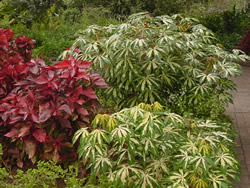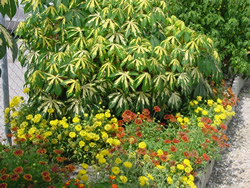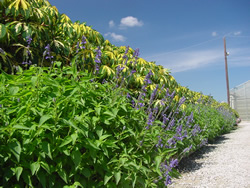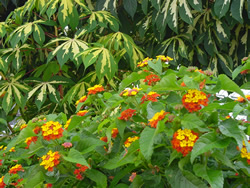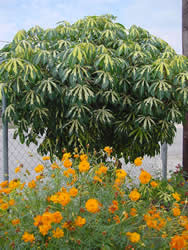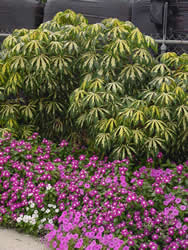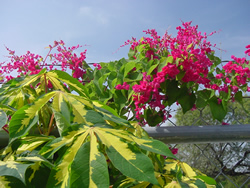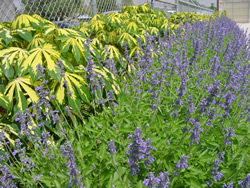
Search
For The Answer
Click here to access our database of
Plant Answers
Search
For The Picture
Click here to access the Google database of plants
and insects
Information
Index
Alphabetical Listing of Topics, Recommendations
and Plants
- Turf Grass & Sod
- Milton Glueck, Host of Milberger's Gardening Show
- Arcadia
Archives -
Greg Grant - Friends of PLANT Answers
Milberger's Nursery and Landscaping
3920 North Loop 1604 E.
San Antonio, TX 78247
210.497.3760
nursery@milbergersa.com
Open 9 to 6 Mon. through Sat.
and 10 to 5 on Sun.

Three exits east of 281, inside of 1604
Next to the Diamond Shamrock station
Please click map for more detailed map and driving directions.

Variegated
Tapioca Adds A Tropical Flare To Texas' Summer Landscape
click on any image below to enlarge, or
click here for
a zip file containing images suitable for media purposes.
All but one (SuperSun Coleus in 1995) of the Texas Superstar*
plants You don't have to worry about variegated tapioca "going out of bloom". Instead, the plants offer foliage as colorful as most flowers with the added advantage of providing a show all summer. Note the scientific name of this selection is 'Variegata' because of its variegated leaves. The common Tapioca which is native to South America (Brazil and Paraguay) has green leaves. Often this variegated form will have a green sprout or shoot appear. Any green shoots or foliage should be removed immediately or it will become dominant over the variegated foliage. The normal, green form of this plant will also grow much faster and larger than the variegated form. The 'Variegata' screams "fiesta" in the summer landscape and it is one of the few variegated plants on which the foliage will not be damaged by intense, direct summer sunlight. Plants work great as centerpieces where taller plants are needed in the center of circular plantings or as backgrounds for lower growing annual bedding plants. Perhaps the premier use of this variegated plant is as a patio or dooryard container specimen where it thrives despite the reflected heat from concrete or pavement. Tapioca is one of the common names of Manihot esculenta 'Variegata' as is cassada, cassava, manioc, yuca, mandioca, shushu, muk shue, cassave, maniok, tapioka, imanoka, maniba, kasaba, katela boodin. The reason we chose the name tapioca is because it is the name of a favorite dessert of mine - tapioca pudding. Tapioca is sort of like Poke Salad made from Poke weed in the Southeastern U.S.-- if the cook doesn't know what he is doing, the meal will kill you! Cooking destroys the prussic acid. In South America, the green leafed Tapioca is grown for its enlarged starch-filled tuberous roots. There is a bitter, poisonous- and a sweet, - nonpoisonous variety of tapioca; however the skin stays poisonous and the sweet variety must be peeled. There are hydrocyanic glucosides (HCN) in all parts of the plant; these glucosides are removed by peeling and boiling in water. The peeled roots of the sweet variety is what the original tapioca pudding was made. I remember enjoying a version of this when I was a baby in Tennessee. I wonder if they were trying to poison me?!? The root of the bitter variety is very poisonous when raw but cooking destroys the hydrocyanic acid -- the cooking water must be discarded just as when cooking Poke Salad. The young leaves are used as vegetable and contain a high amount of vitamin A and C but older leaves are not often used. The bitter ones are grated, diluted in water and pressed in a cylindrical basket-work "press" to extract the juice. The paste of tapioca can be baked into pancake-like bread while the extracted juice is fermented into a strong liquor called kasiri. The juice can also be concentrated and sweetened until it becomes a dark viscous syrup called kasripo (casareep). This syrup has antiseptic properties and is used for flavoring. All of this is to warn folks that variegated tapioca is a clone of a tropical food plant, however, the milky sap of the foliage contains cyanide compounds and SHOULD NOT BE EATEN. Instead of eating this beautiful ornamental plant, go to the closest fast food place to satisfy your hunger. Also, don't worry about your pets eating enough to hurt themselves because all parts of the plants contain distasteful cyanide compounds and have a rough texture which is not very palatable. Deer will eat tapioca but it does not spoil the venison. Variegated tapioca is a heat lover being from South America and does not grow vigorously until night temperatures are warm in spring In fact the foliage will exhibit chilling injury when night temperatures dip much below 50 degrees F. As long as it is hot, variegated tapioca will thrive in most any well drained soil or container potting mix, tolerating a wide range of pH. Variegated tapioca responses to supplemental fertilization of a side-dress application (one cup full distributed evenly around the plant) of a slow-release formulation every month and weekly irrigation in lieu of rainfall-- the soil should be constantly moist and mulch should be used. Plants will grow just as well in alkaline (South central Texas) soil as they will in acidic (East Texas) soils. They are somewhat tolerant to foliar salt exposure in the Coastal Bend area. Full sun brings out the best foliage color, but plants will tolerate partial shade although the foliage will be less dense and not as vibrant in color. Avoidance of over-watering is critical to success-this is NOT a swamp plant. Variegated tapioca offers a bold exciting tropical addition to
our summer palette of annuals used for foliage color in Texas.
This plant has been used at one time or another in every major
Botanical Garden in Texas. The first planting I was impressed
by was at Stephen F. Austin and planted by Greg Grant. I later
learned that Paul Cox had used it at the San Antonio Botanical
Garden in the 1980's. Try some this summer and enjoy the foliage
of South America. |

